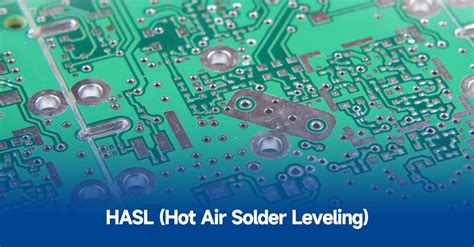What is HASL?
HASL, which stands for Hot Air Solder Leveling, is a surface finish where molten solder is applied to the exposed copper pads and traces on a PCB. The solder, typically a tin-lead alloy, is first applied by dipping or flooding the board. Hot air knives then blow excess solder off, leveling the surface.
The HASL process results in a PCB with solder-coated pads that are immediately solderable. It provides good protection against oxidation and corrosion. HASL has been widely used in the electronics industry for decades and remains a common choice for its simplicity and low cost.
What is ENIG?
ENIG (Electroless Nickel Immersion Gold) is a two-layer metallic surface finish applied to PCB pads and traces. First, a thin layer of nickel (typically 1-5 μm) is deposited via an auto-catalytic electroless process. This nickel layer serves as a diffusion barrier. Then a very thin layer of gold (usually 0.05-0.25 μm) is deposited by immersion plating on top of the nickel.
The gold layer provides excellent solderability, while the nickel barrier prevents copper migration and pad oxidation. ENIG results in a flat, solderable surface that is well-suited for fine-pitch components and wire bonding. It has gained popularity in recent years for its excellent shelf life and compatibility with lead-free soldering processes.
HASL vs ENIG: Key Differences
Here are ten of the most significant differences between HASL and ENIG surface finishes:
1. Composition
- HASL: Tin-lead solder alloy coating (typically 60/40 or 63/37 tin/lead)
- ENIG: Thin layer of immersion gold over electroless nickel
2. Flatness
- HASL: Non-planar surface due to solder meniscus, typically 2-5 mil variation
- ENIG: Flat surface, less than 1 mil variation
Surface Flatness Comparison:
| Finish | Typical Flatness Variation |
|---|---|
| HASL | 2-5 mil (50-125 μm) |
| ENIG | <1 mil (25 μm) |
3. Fine-pitch Suitability
- HASL: Not recommended below 20 mil pitch due to bridging risk
- ENIG: Suitable for fine-pitch down to 12 mil or lower
4. Shelf Life
- HASL: 6-12 months before oxidation degrades solderability
- ENIG: 12-24 months shelf life due to stable gold surface
5. Thermal Shock Resistance
- HASL: Good resistance to thermal shock
- ENIG: Nickel layer prone to fracture under extreme thermal cycling
6. Wire Bonding
- HASL: Not suitable for wire bonding
- ENIG: Gold surface compatible with aluminum and gold wire bonding
7. Solderability
- HASL: Excellent initial solderability, degrades over time
- ENIG: Excellent solderability, even after extended storage
8. Rework
- HASL: Easy to rework and repair
- ENIG: More difficult to rework, may require re-plating
9. Environmental Impact
- HASL: Contains lead, requires wastewater treatment
- ENIG: Lead-free, recyclable gold, fewer environmental concerns
10. Cost
- HASL: Low cost, simple process
- ENIG: Higher cost due to gold price and added process steps
Cost Comparison:
| Finish | Relative Cost |
|---|---|
| HASL | Low |
| ENIG | Medium to High |

Choosing Between HASL and ENIG
The choice between HASL and ENIG depends on the specific requirements of the PCB design and application. Consider the following factors when selecting a surface finish:
- Component pitch and density
- Shelf life and storage requirements
- Soldering process (wave, reflow, hand soldering)
- Environmental and regulatory compliance
- Budget and cost targets
In general, HASL remains a cost-effective choice for simple PCBs with larger components and shorter storage times. ENIG excels in applications requiring fine-pitch components, extended shelf life, or environmentally friendly manufacturing.
FAQ
1. Is HASL RoHS compliant?
Standard tin-lead HASL is not RoHS compliant due to the presence of lead. However, lead-free HASL options using tin-copper, tin-silver, or tin-bismuth alloys are available for RoHS compliance.
2. Can ENIG be used for high-temperature applications?
ENIG has a lower maximum operating temperature compared to HASL due to the risk of nickel layer fracturing under extreme thermal stress. For high-temperature applications, a high-temperature immersion tin (HTIT) or gold over palladium (ENEPIG) finish may be more suitable.
3. How does the solder joint reliability compare between HASL and ENIG?
Both HASL and ENIG can provide reliable solder joints when properly processed. HASL joints may have higher shear strength due to the thicker solder coating, while ENIG joints excel in thermal cycling performance and fine-pitch reliability.
4. Is it possible to selectively apply ENIG to specific areas of a PCB?
Yes, selective ENIG plating is possible using masking techniques to limit the plating to specific areas, such as connectors or test points. This can provide the benefits of ENIG where needed while reducing cost compared to full ENIG plating.
5. Can HASL and ENIG be used together on the same PCB?
While not common, it is possible to use both HASL and ENIG on different areas of the same PCB. This may be done to optimize cost and performance, using ENIG for fine-pitch areas and HASL for larger components. However, the different plating processes and chemistries can introduce challenges in manufacturing and quality control.
Conclusion
HASL and ENIG are both widely used surface finish options for PCBs, each with its own strengths and limitations. HASL offers simplicity, low cost, and good solderability, while ENIG provides a flat surface, long shelf life, and compatibility with fine-pitch components and wire bonding.
When choosing between HASL and ENIG, consider the specific requirements of the PCB design, including component density, storage needs, environmental factors, and budget. By understanding the key differences and trade-offs between these two surface finishes, designers and manufacturers can select the optimal plating method for their PCB projects.
As technology continues to advance, new surface finish options and variations may emerge to meet the evolving needs of the electronics industry. However, the fundamentals of HASL and ENIG will likely remain relevant for the foreseeable future as core PCB plating methods.

No responses yet